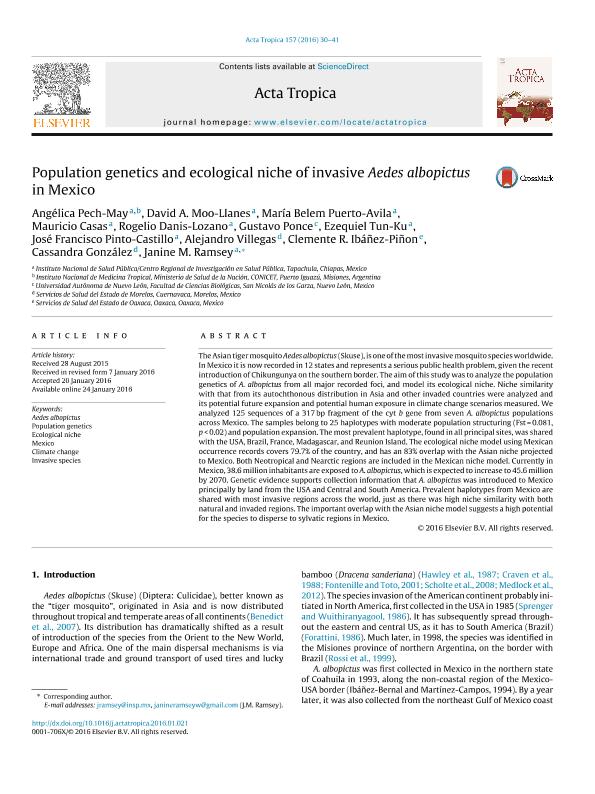Mostrar el registro sencillo del ítem
dc.contributor.author
Pech May, Angélica del Rosario

dc.contributor.author
Moo LLanes, David
dc.contributor.author
Puerto Avila, Maria Belem
dc.contributor.author
Casas, Mauricio
dc.contributor.author
Lozano, Rogelio Danis
dc.contributor.author
Ponce, Gustavo
dc.contributor.author
Tun Ku, Ezequiel
dc.contributor.author
Pinto Castillo, José Francisco
dc.contributor.author
Villegas, Alejandro
dc.contributor.author
Ibanez Piñon, Clemente
dc.contributor.author
Gonzales, Cassandra
dc.contributor.author
Ramsey, Janine

dc.date.available
2019-05-15T21:18:34Z
dc.date.issued
2016-05
dc.identifier.citation
Pech May, Angélica del Rosario; Moo LLanes, David; Puerto Avila, Maria Belem; Casas, Mauricio; Lozano, Rogelio Danis; et al.; Population genetics and ecological niche of invasive Aedes albopictus in Mexico; Elsevier Science; Acta Tropica; 157; 5-2016; 30-41
dc.identifier.issn
0001-706X
dc.identifier.uri
http://hdl.handle.net/11336/76500
dc.description.abstract
The Asian tiger mosquito Aedes albopictus (Skuse), is one of the most invasive mosquito species worldwide. In Mexico it is now recorded in 12 states and represents a serious public health problem, given the recent introduction of Chikungunya on the southern border. The aim of this study was to analyze the population genetics of A. albopictus from all major recorded foci, and model its ecological niche. Niche similarity with that from its autochthonous distribution in Asia and other invaded countries were analyzed and its potential future expansion and potential human exposure in climate change scenarios measured. We analyzed 125 sequences of a 317. bp fragment of the cyt b gene from seven A. albopictus populations across Mexico. The samples belong to 25 haplotypes with moderate population structuring (Fst. = 0.081, p<. 0.02) and population expansion. The most prevalent haplotype, found in all principal sites, was shared with the USA, Brazil, France, Madagascar, and Reunion Island. The ecological niche model using Mexican occurrence records covers 79.7% of the country, and has an 83% overlap with the Asian niche projected to Mexico. Both Neotropical and Nearctic regions are included in the Mexican niche model. Currently in Mexico, 38.6 million inhabitants are exposed to A. albopictus, which is expected to increase to 45.6 million by 2070. Genetic evidence supports collection information that A. albopictus was introduced to Mexico principally by land from the USA and Central and South America. Prevalent haplotypes from Mexico are shared with most invasive regions across the world, just as there was high niche similarity with both natural and invaded regions. The important overlap with the Asian niche model suggests a high potential for the species to disperse to sylvatic regions in Mexico.
dc.format
application/pdf
dc.language.iso
eng
dc.publisher
Elsevier Science

dc.rights
info:eu-repo/semantics/openAccess
dc.rights.uri
https://creativecommons.org/licenses/by-nc-sa/2.5/ar/
dc.subject
AEDES ALBOPICTUS
dc.subject
CLIMATE CHANGE
dc.subject
ECOLOGICAL NICHE
dc.subject
INVASIVE SPECIES
dc.subject
MEXICO
dc.subject
POPULATION GENETICS
dc.subject.classification
Otras Ciencias Biológicas

dc.subject.classification
Ciencias Biológicas

dc.subject.classification
CIENCIAS NATURALES Y EXACTAS

dc.title
Population genetics and ecological niche of invasive Aedes albopictus in Mexico
dc.type
info:eu-repo/semantics/article
dc.type
info:ar-repo/semantics/artículo
dc.type
info:eu-repo/semantics/publishedVersion
dc.date.updated
2019-05-10T14:11:54Z
dc.journal.volume
157
dc.journal.pagination
30-41
dc.journal.pais
Países Bajos

dc.journal.ciudad
Amsterdam
dc.description.fil
Fil: Pech May, Angélica del Rosario. Instituto Nacional de Salud Publica; México. Consejo Nacional de Investigaciones Científicas y Técnicas; Argentina. Ministerio de Salud. Instituto Nacional de Medicina Tropical; Argentina
dc.description.fil
Fil: Moo LLanes, David. Instituto Nacional de Salud Publica; México
dc.description.fil
Fil: Puerto Avila, Maria Belem. Instituto Nacional de Salud Publica; México
dc.description.fil
Fil: Casas, Mauricio. Instituto Nacional de Salud Publica; México
dc.description.fil
Fil: Lozano, Rogelio Danis. Instituto Nacional de Salud Publica; México
dc.description.fil
Fil: Ponce, Gustavo. Universidad Autónoma de Nuevo León; México
dc.description.fil
Fil: Tun Ku, Ezequiel. Instituto Nacional de Salud Publica; México
dc.description.fil
Fil: Pinto Castillo, José Francisco. Instituto Nacional de Salud Publica; México
dc.description.fil
Fil: Villegas, Alejandro. Servicios de Salud de Morelos; México
dc.description.fil
Fil: Ibanez Piñon, Clemente. Servicios de Salud del Estado de Oaxaca; México
dc.description.fil
Fil: Gonzales, Cassandra. Servicios de Salud de Morelos; México
dc.description.fil
Fil: Ramsey, Janine. Instituto Nacional de Salud Publica; México
dc.journal.title
Acta Tropica

dc.relation.alternativeid
info:eu-repo/semantics/altIdentifier/doi/http://dx.doi.org/10.1016/j.actatropica.2016.01.021
dc.relation.alternativeid
info:eu-repo/semantics/altIdentifier/url/https://www.sciencedirect.com/science/article/pii/S0001706X16300213
Archivos asociados
